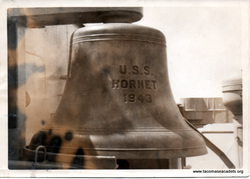USS HORNET
Information provided by the USS HORNET MUSEUM website
THE TWO HUNDRED YEAR LEGACY OF HORNET
The aircraft carrier Hornet (CV-12) is the eighth ship of the United Stated Navy to bear the name. Six earlier Hornets date from 1775, but CV-12’s greatest legacy comes from the seventh Hornet (CV-8).
1775 - The first Hornet is christened. Hornet would become one of the most distinguished names in American naval history with her performance in the Revolutionary War. The first two ships in the new Continental Navy were Hornet and Wasp.
1805 - In a one hour gun battle, the second Hornet, along with another sloop, battered the canons at the citadel at Djerna, damaging one of the walls enough to allow the Marines to rush over it and capture the citadel, thus deciding the war with the Barbary Pirates.
1942 - The seventh Hornet (CV-8) launched 16 Army B-25s to strike the Japanese home islands in one of the most daring raids in the history of warfare -- the "Doolittle Raid." She went on to fight at the Battle of Midway and was lost to an overwhelming air attack at the Battle of Santa Cruz.
1943 - The eighth Hornet (CV-12) was commissioned just 15 months after her keel was laid.
The aircraft carrier Hornet (CV-12) is the eighth ship of the United Stated Navy to bear the name. Six earlier Hornets date from 1775, but CV-12’s greatest legacy comes from the seventh Hornet (CV-8).
1775 - The first Hornet is christened. Hornet would become one of the most distinguished names in American naval history with her performance in the Revolutionary War. The first two ships in the new Continental Navy were Hornet and Wasp.
1805 - In a one hour gun battle, the second Hornet, along with another sloop, battered the canons at the citadel at Djerna, damaging one of the walls enough to allow the Marines to rush over it and capture the citadel, thus deciding the war with the Barbary Pirates.
1942 - The seventh Hornet (CV-8) launched 16 Army B-25s to strike the Japanese home islands in one of the most daring raids in the history of warfare -- the "Doolittle Raid." She went on to fight at the Battle of Midway and was lost to an overwhelming air attack at the Battle of Santa Cruz.
1943 - The eighth Hornet (CV-12) was commissioned just 15 months after her keel was laid.
USS HORNET CV-12: THE LEGACY CONTINUES
The USS Hornet CV-12 is one of the 24 legendary Essex-class aircraft carriers built during and after World War II. Built at Newport News, Virginia, and the eighth ship to be named “Hornet,” she is one of the most decorated ships of the US Navy.
For 16 continuous months Hornet was in action in the forward areas of the Pacific combat zone, sometimes within 40 miles of the Japanese home islands.
The USS Hornet CV-12 is one of the 24 legendary Essex-class aircraft carriers built during and after World War II. Built at Newport News, Virginia, and the eighth ship to be named “Hornet,” she is one of the most decorated ships of the US Navy.
For 16 continuous months Hornet was in action in the forward areas of the Pacific combat zone, sometimes within 40 miles of the Japanese home islands.
- Under air attack 59 times, she was never seriously damaged.
- Her aircraft destroyed 1,410 Japanese aircraft, only Essex exceeded this record.
- Her air groups destroyed or damaged 1,269,710 tons of enemy shipping.
- 72 enemy aircraft shot down in one day during the famous “Great Marianas Turkey Shoot.”
- 10 Hornet pilots attained "Ace in a Day" status.
- 255 aircraft shot down in a month.
- 30 of 42 VF-2 Hellcat pilots were aces.
- Supported nearly every Pacific amphibious landing after March 1944.
- Scored the critical first hits in sinking the super battleship YAMATO.
- Launched the first carrier aircraft strikes in support of the liberation of the Philippine Islands.
- In 1945 launched the first strikes against Tokyo since the 1942 Doolittle Raid.
"A HERITAGE OF EXCELLENCE" is the ship's creed:
Hornet participated in World War II, the Vietnam War, and the first moon missions.
Hornet participated in World War II, the Vietnam War, and the first moon missions.
- Earned 9 battle stars for her service in WWII
- Awarded the Presidential Unit Citation for her WWII operations (only nine carriers so cited).
- Flawlessly recovered the Apollo 11 space capsule and the first men to walk on the moon. A few months later, she also recovered the Apollo 12 capsule and its all-Navy crew; 1969
- USS Hornet (CVS-12) is designated a National Historic Landmark; 1991
- Hornet opens to the public as an aircraft carrier museum in Alameda, California; 1998
- USS Hornet is designated a State Historic Landmark; 1999.
- The F/A-18 strike fighter carries on the name of Hornet in today's NAVY.


